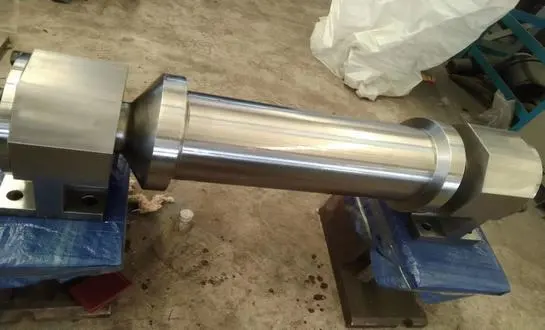What Factors Determine the Best Roll Material for Your Needs?
Selecting the optimal roll material is a critical decision that can significantly impact the performance and longevity of your rolling machine. The choice of material depends on various factors, including the type of metal being processed, the desired surface finish, and the operational conditions of your rolling mill.
Metal Type and Hardness
The type of metal you're processing plays a crucial role in determining the appropriate roll material. Softer metals like aluminum or copper may require rolls made from materials with different properties compared to those used for harder metals like steel. The hardness of the roll material should be compatible with the metal being rolled to ensure optimal performance and minimize wear.
Operating Temperature
The temperature at which the rolling process occurs is another critical factor. Hot rolling operations, typically performed at temperatures above the metal's recrystallization temperature, require rolls that can withstand high heat and thermal shock. Materials like high-chrome steel or tungsten carbide are often used in hot rolling applications due to their excellent heat resistance and wear properties.
Surface Finish Requirements
The desired surface finish of your final product also influences the choice of roll material. Some materials are better suited for achieving specific surface characteristics, such as high smoothness or controlled roughness. For instance, rolls made from certain alloy steels or ceramic materials can provide superior surface finishes for applications requiring high-quality aesthetics or precise dimensional control.
Environmental Considerations
In 2025, environmental factors have become increasingly important in material selection. Some roll materials may offer better recyclability or reduced environmental impact during production and use. Consider materials that align with your company's sustainability goals and any relevant environmental regulations in your industry.
Understanding Roll Hardness and Durability Requirements
Roll hardness and durability are crucial factors that directly impact the performance and lifespan of your roll for rolling machine. Understanding these requirements is essential for making an informed decision that balances production efficiency with maintenance costs.
The Importance of Roll Hardness
Roll hardness affects several aspects of the rolling process, including:
- Wear resistance: Harder rolls generally offer better resistance to wear, potentially extending the operational life of the roll.
- Surface finish: The hardness of the roll can influence the surface quality of the rolled product.
- Rolling force: Harder rolls may require higher rolling forces, which can impact energy consumption and machine wear.
In 2025, advancements in metallurgy have led to the development of rolls with optimized hardness profiles, allowing for better performance across various applications.
Durability Considerations
Durability goes beyond mere hardness and encompasses the roll's ability to withstand the rigors of the rolling process over time. Key durability factors include:
- Thermal stability: The ability to maintain properties under varying temperature conditions.
- Crack resistance: Resistance to the formation and propagation of cracks during operation.
- Corrosion resistance: Important for rolls used in environments where corrosive materials may be present.
Modern rolls are often engineered with composite materials or surface treatments to enhance durability while maintaining optimal performance characteristics.
Balancing Hardness and Toughness
While hardness is crucial, it's essential to balance it with toughness to prevent brittle failure. Rolls that are too hard may be prone to chipping or cracking under high stress. Advanced materials and heat treatment processes in 2025 allow for rolls that combine high hardness with improved toughness, offering a better overall performance profile.
How to Match Roll Specifications to Your Production Goals
Aligning your roll for rolling machine specifications with your production goals is essential for achieving optimal results in your metal processing operations. This process involves a careful analysis of your production requirements and the capabilities of different roll types.
Analyzing Production Volume and Speed
Your production volume and desired rolling speed are primary factors in selecting the appropriate roll specifications. High-volume production may require rolls with enhanced wear resistance and thermal stability to maintain consistent performance over extended periods. Consider the following:
- Roll diameter: Larger diameters can often handle higher speeds and loads.
- Roll length: Affects the width of material that can be processed.
- Surface finish: Precision-ground rolls may be necessary for high-speed operations to maintain product quality.
Precision and Tolerance Requirements
The level of precision required in your final product will influence your roll selection. Industries such as aerospace or electronics may demand rolls capable of producing materials with extremely tight tolerances. In 2025, advanced roll design and manufacturing techniques allow for unprecedented levels of precision in rolling operations.
Customization and Flexibility
Consider whether your production goals require flexibility in terms of the materials or profiles you can process. Some modern rolls are designed with interchangeable components or adjustable features that allow for greater versatility in production lines.
Future-Proofing Your Investment
When selecting a roll for rolling machine, it's important to consider not just your current production goals, but also potential future needs. Rolls that offer adaptability or can be easily refurbished may provide long-term value as your production requirements evolve.
In conclusion, choosing the right roll for your rolling machine in 2025 requires a comprehensive understanding of your material processing needs, production goals, and the latest advancements in roll technology. By carefully considering factors such as material properties, hardness requirements, and production specifications, you can select a roll that optimizes your metal processing operations. Remember that the ideal roll should balance performance, durability, and cost-effectiveness to ensure long-term success in your manufacturing processes. If you need further assistance in selecting the perfect roll for rolling machine for your specific application, don't hesitate to reach out to industry experts. For more information or personalized advice, contact us at oiltools15@welongpost.com. Trust in Welong to provide you with the expertise and quality products you need to excel in your metal processing operations.





